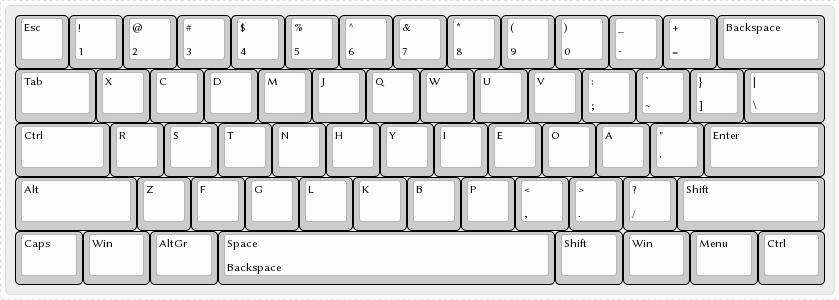About Vas Keys
Vas Keys is a keyboard layout that I based off Vu Keys by Vu Dang. The modifications are in order to improve the layout for Japanese text and mixed Japanese-English text, similar to TypeHack, although sometimes they are minor improvements for English text as well. Improvements are calculated through the Keyboard Layout Analyzer. For the most common words, for English, is scores slightly worse than Vu Keys but better than TypeHack. For Japanese, it scores worse than TypeHack but much better than Vu Keys. I developed it because I had become good at Vu Keys and didn’t want to switch my layout completely, especially the vowels. Vu Keys’ basic principle of using as many fingers as possible is preserved. My personal best in monkeytype is 185 WPM with this layout.

Design decisions
This layout, like Vu Keys, is designed with the notion that you should use all 10 fingers for typing. This means it stresses the pinkies more, which many people disagree with. Each person is anatomically different, and has exercised their fingers different. There is no compatibility with QWERTY. I am left-handed and this layout is optimised for left-hand use. You can mirror all or parts of for right-hand use. Standard 60% staggered layout is provided, but it's recommended you use an ortholinear keyboard, split spacebar keyboard, or JIS layout keyboard instead.
Thumbs
Your thumbs are your strongers fingers. Most people type spacebar with the same thumb; I use my left thumb. Shift key is typed with the right hand. AltGr is typed on the left hand, so that you can enter the 4th layer by using both your thumbs.
Non-thumbs
The middle finger is the longest finger, so it can move one up easier; this is the easiest location not on the home row. Index finger is the most flexible, so it can move to several places without struggle, so it's used as the catch-all finger. Ring finger has the least flexibility.
Modifiers
Ctrl is the most used modifier, Alt is next. They are placed on the left pinky so that they are easy to combine with the shift key on the thumb row.
Home row
The most frequent keys are placed in the easiest-to-reach places. Vu Keys organises vowels all on the same side, and this is preserved. U is placed in the second-easiest location. This is not done for the H key, as it
would make the very common TH bigram more difficult to type because it uses the same finger. It's in the third-easiest location instead.
To balance the commonality of vowels, relatively rarer letters are placed on the rest of the right-hand side. Care is taken not to overdo it and thus ruin left-right balance.
N and R are swapped compared to Vu Keys. N is more common and benefits from this placement, especially in Japanese.
K is very common in Japanese, so it's placed on the left-hand side to maintain left-right balance, where X is for Vu Keys. This isn't an ideal placement, as I didn't want to impact English performance too much. It's at least typed with the index finger, which is a huge benefit. Bigrams are slightly awkward as they require a mild hand adjustment. Recommendations are welcome.
XZJQ are the rarest letters and so are placed in the hardest-to-reach places. V is moved to the right ring finger because it isn't nearly rare enough to warrant its placement in Vu Keys.
J is placed on the left-hand side to improve left-right balance in Japanese due to its commonality.
Semicolon and apostrophe are swapped compared to Vu Keys, because I type apostrophe more than semicolon.
Realisations
The king of keyboard layout analyser is X7-2h. Vu keys variants will likely never beat it because they stress the pinkies too much and don't use the middle fingers enough.
You can't solve Japanese optimally while also having a vowel-consonant left-right split. Even the most aggressive optimisations have the vowel-hand dominate. Vowels and consonants should be mixed to make the layout phonotactically neutral. This will also help with languages more consonant-heavy than modern English, like Germanic languages with fewer Latin and French loanwords.